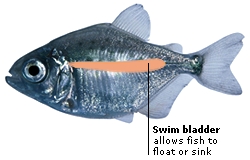DK Science: Floating
When an object such as a boat or an airship rests in a fluid (a liquid or gas), it has to displace (push aside) some of the fluid to make room for itself. The object’s weight pulls it downwards. But the pressure of the fluid all around the object tries to push it upwards with a force called upthrust. The object SINKS if the upthrust is less than its weight, but floats if the upthrust is equal to, or more than its weight.
Hot air is less dense than cooler air, so the hot air in a balloon weighs less than the same volume of cool air. The weight of the airship pulls it downwards, but the air around the balloon pushes it upwards with a force called upthrust. If the upthrust is equal to or greater than the total weight of the balloon, the basket, and the hot air, the airship floats.
When a boat floats, it displaces some of the water underneath it. As the weight of the boat pushes down on the water, the water pushes up on the boat with an upward force called buoyancy. The larger the boat, the greater the buoyancy. The boat floats if the buoyancy is as great as or greater than the weight of the boat.
Archimedes is best known for realizing that a floating object displaces its own weight in a fluid. Legend has it that he worked this out in his bath. As he stepped into the bathtub, water splashed over the side. He found that the weight of this water equalled his body weight. This idea is known as Archimedes’ Principle.
Not everything will float. A block of wood will float on water, but a lump of iron exactly the same size will sink. This is because a piece of wood of a certain size weighs less than the same volume of water, so wood floats on water. However, iron is much heavier than either wood or water. A block of iron weighs more than the same volume of water. This is why iron sinks in water.

Some fish can raise or lower themselves in water using their swim bladder. This is an organ inside their body that they can fill with gas to make their bodies lighter, so they rise towards the surface. When they reduce the amount of gas in the swim bladder, their bodies become heavier and sink.
The more cargo a ship carries, the deeper it sits in the water. Ships also displace varying amounts of water according to the saltiness and temperature of the water. This varies from ocean to ocean around the world. Large ships have a mark called a Plimsoll line painted on their sides. This shows how much weight they can safely carry in different parts of the world.
